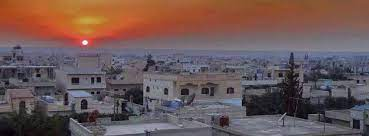Sadad is an ancient village in Syria that was mentioned twice in the Old Testament . It is located 60 km south of Homs and 100 km northeast of Damascus. Archaeological evidence shows that it was inhabited since the earliest times and was part of Canaan territory. In addition, the city was an important station for commercial caravans.
The name Sadad is considered one of the Semitic names, and translations differed about the meaning of the name in the Aramaic language. It is believed to mean the side of the mountain which was a tower on the northern Canaanite border. It is also said that the meaning of the name is the precious jewel, which is considered its commercial name.
The actual history of Sadad dates back to the second millennium BC. Among the most important archaeological remains that were found there are, the tombs, or sarcophagi located to the northwest of Sadad, specifically in the Amr region, which is called the “monastery” in Syriac. The monastery was called “Mar Mama,” which was a cathedral where bishops were ordained. “Mar Mama” was destroyed in 1715 AD, and a number of stone coffins of famous and great people who influenced the history of the region were found in it. Archaeological expeditions to Sadad were able to discover a pagan temple belonging to the Aramaic god (Haded), which dates back to before the birth of Jesus Christ. This temple was located far from urbanization between fields and orchards, as it was believed that it was a temple to the gods of fertility.
 It was built in several stages. The first stage was the construction of the temple, which was a high dome built of large stones, with broad walls that were shaped like a circle, which was later converted into a church.
It was built in several stages. The first stage was the construction of the temple, which was a high dome built of large stones, with broad walls that were shaped like a circle, which was later converted into a church.
The second stage was built with large columns and a set of arches, which eventually form a stone roof, while the third and final stage was conducted through the constructing a number of canopies from the south to the north of the temple with a wooden roof ending with an opening overlooking the west, the church door. St. George’s Church or Al-Khidr Church that was built on the ruins of this temple. The church still exists today.
The floor was paved with modern tiles in 1955. There is a basalt stone above the baptismal font with inscriptions in the Greek letter referring to the church’s ancient history.
The finest of the church is the ancient frescoes and the unique collection of religious paintings by the 18th-century artist Bishop Ibrahim Al-Yazji. These paintings are considered to be among the most attractive antiquities intended by tourists and they represent some religious events and pictures of the fathers and saints.
Another important monument in Sadad is an ancient 22-meter-high Roman tower that was built to monitor trade caravans. It consisted of several layers and was built of large and huge cubic limestone. This tower is linked to an ancient mound built of stones and mud by an underground tunnel that was used in the past to observe the possible invasion of the town.
The village also contained the remains of the Arab poet Abu Firas al-Hamadani for over a thousand years until his remains were transferred to the city of Homs.
 Systematic school education in Sadad dates back to the early twentieth century. It has one of the oldest secondary schools in the Syrian governorates. The village is famous for the large number of educated people, as it is the mother village for many doctors, engineers, teachers, lawyers, judges and professors, such as the scientist Riad Jarjour, and Haitham Al-Khalil, a surgeon at the French University of Roy. The town also includes several churches that run programs to teach the Syriac language free of charge.
Systematic school education in Sadad dates back to the early twentieth century. It has one of the oldest secondary schools in the Syrian governorates. The village is famous for the large number of educated people, as it is the mother village for many doctors, engineers, teachers, lawyers, judges and professors, such as the scientist Riad Jarjour, and Haitham Al-Khalil, a surgeon at the French University of Roy. The town also includes several churches that run programs to teach the Syriac language free of charge.
Some of the village’s sons immigrated and the others established new villages and neighborhoods within the major cities. Several villages emerged from Sadad, namely: Hafar, Fahaila, Fairoza, Zaidel, Al-Mushrifa, and Maskanah.
Sadad witnesses many recreational and cultural activities, the most important of which is the “Sadad Al-Araqah” Festival. Through this festival, the village’s landmarks and ancient history are highlighted.
Amal Farhat

